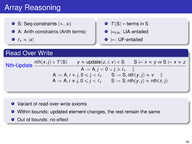 | EasyChair Smart Slide | User Guide/Log in |
| Home |

Dynamic arrays, also referred to as vectors, are fundamental data structures used in many programs. Modeling their semantics efficiently is crucial when reasoning about such programs. The theory of arrays is widely supported but is not ideal, because the number of elements is fixed (determined by its index sort) and cannot be adjusted, which is a problem, given that the length of vectors often plays an important role when reasoning about vector programs. In this paper, we propose reasoning about vectors using a theory of sequences. We introduce the theory, propose a basic calculus adapted from one for the theory of strings, and extend it to efficiently handle common vector operations. We prove that our calculus is sound and show how to construct a model when it terminates with a saturated configuration. Finally, we describe an implementation of the calculus in cvc5 and demonstrate its efficacy by evaluating it on verification conditions for smart contracts and benchmarks derived from existing array benchmarks.



























